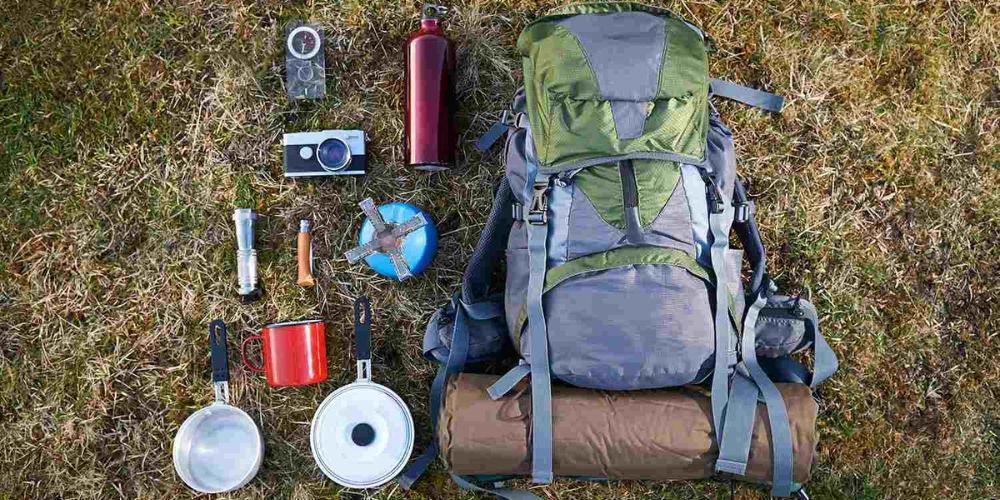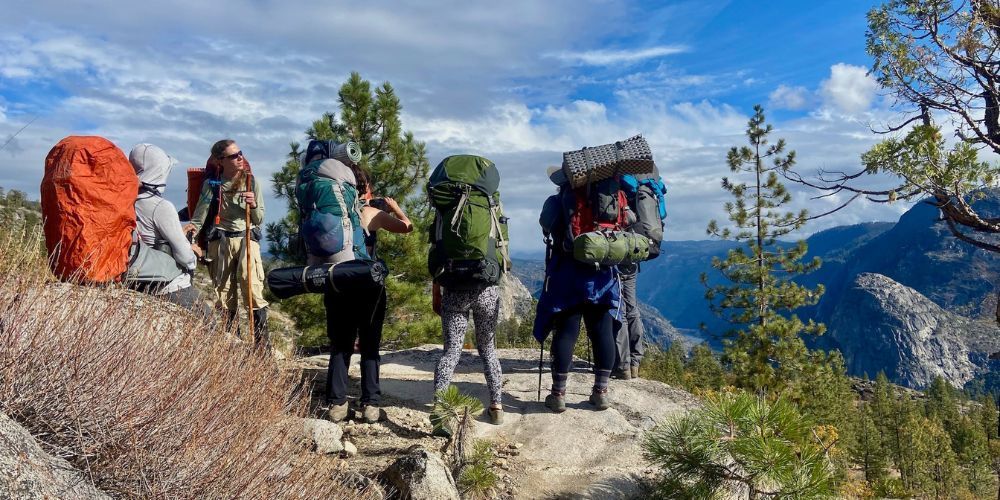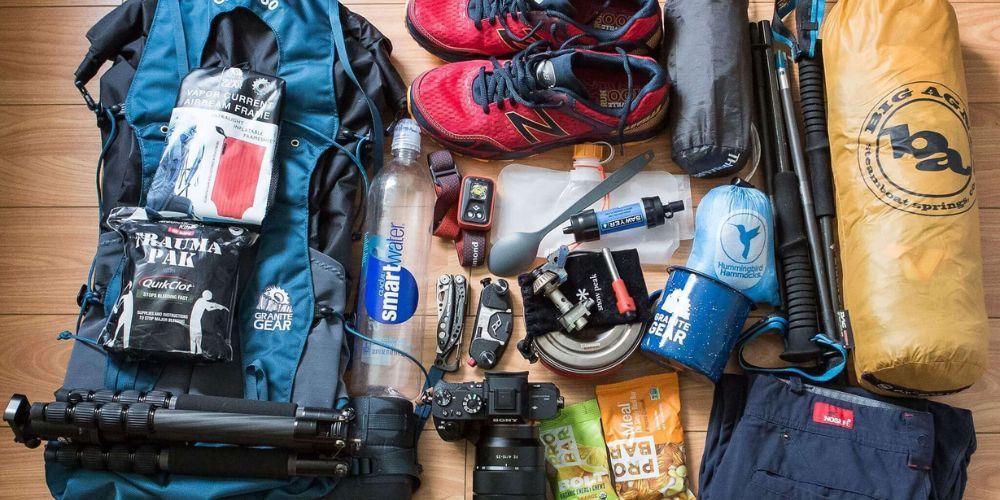Essential Items for Your Backpacking Trip: The Ultimate Packing List
July 13, 2024
Backpacking offers an escape into nature's purest forms but preparing correctly can make or break your adventure. The question pressing many adventurers' minds is simple: "What do I absolutely need to pack?" The anxiety of leaving behind essential gear can cast a shadow over the excitement of exploration.
Starting with methodically categorizing your essentials turns chaos into clarity. Begin with foundational items like a dependable backpack, sturdy shelter, and a cozy sleeping system which makes all the difference when you're miles away from civilization. By crafting this guide with careful attention and field-tested advice, we've gathered everything you need for a successful journey - ensuring peace of mind as you embark on your next great adventure.
The essential items for a backpacking trip include hiking boots or shoes, a backpack, tent, sleeping bag and sleeping pad, stove and fuel, kitchen supplies, plenty of food, water bottles and water-treatment supplies, weather-appropriate clothing, emergency and hygiene supplies, small repair kit. Additionally, it's important to have a map (preferably in a waterproof sleeve), compass for navigation, and health and hygiene items such as prescription medications and sun protection.

Creating a Comprehensive Packing List
Putting together a comprehensive packing list is like preparing a roadmap - it ensures you navigate your outdoor journey without any unwanted detours. One of the first steps in creating this packing list is to categorize items effectively.
Step I - Categorize Your Items
By breaking down your packing list into categories such as clothing, gear, food, and safety, you can systematically organize and account for every essential item required for your trip. Imagine the satisfaction of checking off each category as you pack, knowing that nothing has been forgotten. This systematic approach also reduces the likelihood of overlooking important items that could make or break your trip.
For instance, under "clothing," you would include weather-appropriate clothing for different conditions, while "gear" would cover tools and camping equipment. By including a category for "safety," you would remember to carry essentials such as first aid kits and emergency supplies.
Step II - Focus on the 'Big Three'
The 'Big Three' items are crucial components of your backpacking gear: the backpack itself, shelter, and sleeping system. These three elements have the most significant impact on your comfort and overall experience during the trip.
Think of them as the heart of your outdoor adventure setup - your lifelines in the wild. Just like every great team needs strong leaders, your backpack, shelter, and sleeping system must be sturdy and reliable. Lightweight and durable gear options play a pivotal role in reducing overall weight burden. For example, when choosing a backpack brand, Osprey stands out for their comfortable and functional designs, while shelters from MSR are renowned for their quality construction. For sleeping pads, Therm-a-Rest offers a great selection known for their comfort and durability. Choosing high-quality options for these essential items sets a solid foundation for an enjoyable backpacking experience.
Step III - Use a Checklist
Crossing off items from a checklist not only ensures that you've packed everything you need but also provides peace of mind. Utilizing pre-made checklists tailored to different trip lengths and environmental conditions makes this process even more seamless.
Imagine having access to downloadable templates specifically designed for weekend getaways or extended expeditions in diverse terrains can be incredibly helpful. These checklists cover all essential items along with any extras needed based on specific trip requirements.
The key takeaway here is that creating a comprehensive packing list involves meticulous planning and organization. By categorizing items, focusing on the 'Big Three', and utilizing pre-made checklists, you'll equip yourself with all the necessary gear for an unforgettable backpacking adventure.
Preparing the perfect backpacking experience involves selecting the right clothing and footwear to meet the demands of the trail. Let's now explore how these elements can enhance your outdoor escapade.
Essential Clothing and Footwear
When you're out in the wilderness, having the right clothing and footwear is crucial. Here are some key considerations when it comes to your backpacking attire.
Layer Up for Comfort
Think about your clothing in terms of layers. This helps you adjust to any kind of weather you might encounter while on your adventure.
Start with a base layer made of moisture-wicking material like merino wool or synthetic fibers. These materials help keep sweat away from your skin, so you stay warm and dry in colder conditions and cool in warmer ones. They also resist odors.
Moving on to mid-layers, think about insulation. You want something that is warm but not bulky. Wool is a popular choice here, but fleece is another option to consider because it provides warmth even if it gets wet.
Then there are the outer layers - these need to be waterproof to protect you from rain or snow. Look for materials that are both breathable and durable, like Gore-Tex or eVent.
Selecting the right layers should ensure that you're prepared for a variety of weather conditions.
Footwear Selection
Your feet are vital for getting around on a backpacking trip, so choosing the right footwear is super important.
Think of your feet as the tires of a car; they need to be capable of handling different terrains.
For gentle hikes on smooth trails, trail runners can provide the grip and comfort needed without being too heavy.
For rockier or more rugged trails, opt for sturdy hiking boots with good ankle support. The last thing you want is to twist an ankle halfway through your trip!
Extra Clothing
Always pack extra socks and underwear! Keeping your feet and body dry is crucial to avoid discomfort and potential health issues.
Even if the forecast predicts mild weather, it's smart to bring a hat and gloves for added warmth and protection. Weather in the wild can be unpredictable—better safe than sorry!
Armed with these clothing and footwear essentials, you'll be well-prepared for whatever nature throws your way during your backpacking journey.
Now that we've covered essential items for your backpacking trip, let's shift our focus to managing the weight of your backpack to ensure comfort and efficiency during your journey.

Managing Backpack Weight
When it comes to backpacking, every gram counts. The weight on your back can make all the difference between an enjoyable, energizing hike and an exhausting, painful experience. Since we've already established the essentials, it's time to assess your gear with a streamlined, minimalist approach in mind.
First off, take a step back and look at each item you plan to bring. Do you really need it? Can you use one item for multiple purposes? For instance, a bandana isn't just a sweat rag—it can also serve as a pot holder, a scarf in the cold, or even be used as a makeshift bandage in case of an emergency. Every ounce you can shave off contributes to lightening your load and making your journey more manageable.
Another crucial aspect to consider when managing backpack weight is investing in lightweight gear. Ultralight equipment can be real game-changers in reducing the overall load on your shoulders. Look for options like titanium utensils that are strong but incredibly light, and compact camping stoves that offer performance without excess weight. Additionally, you might want to consider investing in a sleeping bag that is lightweight yet rated for the lowest expected temperature. These are examples of how choosing lightweight gear can significantly decrease the burden on your back without sacrificing functionality.
When it comes to food and water, there are several strategies you can employ to lighten your load. Calorie-dense meals that require minimal cooking can save both weight and fuel. Consider preparing dehydrated meals and packing energy bars for quick snacks on the trail. Furthermore, the water filtration system you choose can make a significant impact on your backpack weight. Options like the Sawyer Squeeze provide effective water purification without the need to carry excess water weight.
By carefully assessing every item for necessity, opting for lightweight gear, and planning food and water supplies smartly, you'll ensure that your backpack is as light and efficient as possible for your backpacking adventure.
As you prepare for the great outdoors, it's essential to equip yourself with safety gear and protection to ensure a secure and enjoyable expedition.
Safety Gear and Protection
When it comes to backpacking, safety should always be a top priority. Beyond avoiding injuries, having the right safety gear and protection can make a significant difference in an emergency situation. Let's explore some essential items that you should pack to keep yourself safe on the trail.
Navigation Tools: A Must-Have
A map and compass are like the stars to a sailor, especially when your GPS or smartphone battery decides to call it quits. These analog tools may seem old-fashioned, but they're reliable and don't rely on batteries or satellite signals. Always have these as your primary navigation tools. They provide a sense of direction when signals are poor or technology fails you.
If you're not confident with a map and compass, consider taking a basic navigation course. It's an investment that will add an extra layer of security to your outdoor adventures. Plus, there's something quite satisfying about navigating using traditional tools rather than relying solely on modern gadgets.
First Aid Kit: Your Safety Net
A well-stocked first aid kit tailored to the specific risks of your trip is an absolute must. There's no one-size-fits-all kit since different trips carry different potential hazards. For example, if you're hiking in high altitudes, medications for altitude sickness are essential. In addition to basic supplies like bandages and antiseptics, invest in blister treatment items too. These often-overlooked remedies can be a lifesaver when you're facing long days on the trail.
Emergency Supplies: Be Prepared for Anything
It's crucial to carry emergency items such as a whistle, fire starter, and an emergency shelter. Even if you're carrying a tent, an emergency shelter is essential for unexpected situations. A whistle may seem simple, but it's one of the best signaling devices in emergencies due to its piercing sound that can travel long distances. Fires can provide warmth, light, comfort, and can be used for signaling. It's all about being prepared with multiple avenues for obtaining help or providing self-assistance in case of unforeseen circumstances.
Remember: While it might feel like overkill carrying all these items at times, it’s better to be over-prepared than caught off guard in an emergency. Each item plays a crucial role in ensuring your safety during backpacking trips.
In packing these safety essentials along with other key items in your backpacking checklist, you're cementing a solid foundation for more enjoyable and secure outdoor adventures.
Having covered the safety essentials for your backpacking trip, let's now turn our attention to the tools and equipment that will enhance your experience on the trail.

Key Backpacking Equipment
When it comes to backpacking, having the right gear can make or break your experience. Let's talk about some essential equipment you shouldn't leave home without:
Camping Stove and Cookware
Cooking gear is essential for preparing meals on the trail. A compact, efficient cooking setup is crucial to keep your pack light while ensuring you can still enjoy hot meals. Consider investing in a portable stove like the popular Jetboil, known for its high efficiency and quick boiling capabilities. Pair this with lightweight cookware to create a practical, space-saving cooking system.
Sleeping Bag and Sleeping Pad
A good night's sleep is key to a successful backpacking trip. Investing in a quality sleeping bag and comfortable sleeping pad can significantly enhance your outdoor sleeping experience. When choosing a sleeping bag, look for one with a suitable temperature rating for the environment you'll be in. This ensures you stay warm and comfortable throughout the night. As for the sleeping pad, opt for one that provides adequate cushioning and insulation from the cold ground.
Multi-tool
Having a reliable multi-tool can save the day in numerous situations while you're out on the trail. A Swiss Army knife is a classic choice known for its versatility and reliability. It can handle various small tasks such as cutting rope, repairing gear, opening cans, and many other practical functions. Its compact size makes it a convenient addition to your backpacking essentials without weighing you down.
Each of these items plays a crucial role in ensuring that your backpacking trip goes smoothly. From cooking hot meals at your campsite to getting a restful night's sleep under the stars, the right equipment sets the stage for a memorable outdoor adventure.
Remember, carefully selecting your backpacking equipment tailored to your specific needs can significantly enhance your comfort and enjoyment during your outdoor escapades.
As we dive further into preparing for an outdoor excursion, let's now explore another set of indispensable items—ones that truly make hiking experiences extraordinary.
Must-Have Hiking Items
When you're out on the trail, having the right gear can make all the difference. It's not just about packing light but also about packing smart. Let's break down some key items that are an absolute must for a successful and safe hiking trip.
Hydration System
It is crucial to have a reliable hydration system while you're on the trail. Your choice should factor in your personal needs and the terrain's availability of water sources. Water bottles or hydration bladders with easy access are great options. Consider how much water you'll need between stops where you can refill and choose a capacity that matches those needs. Remember to drink water regularly and don't wait until you're thirsty as staying hydrated is vital for maintaining your energy levels and overall well-being while hiking. An adequate hydration system ensures convenient access to water, especially during strenuous climbs or in warm weather.
Navigation and Communication
Being able to navigate efficiently is essential for safety, particularly if your hike extends into the evening. A reliable headlamp with extra batteries should always find a place in your backpack. It not only serves as a guiding light in the dark but also comes in handy should your hike take longer than anticipated. Furthermore, carry a fully charged power bank to keep your electronic devices operational. In case of an emergency, being able to communicate with others or access GPS and mapping applications on your phone can be invaluable.
Imagine hiking through the woods as dusk falls; having a reliable headlamp can make navigating back to your campsite a stress-free experience. Similarly, in situations where electronic communication becomes necessary due to unforeseen circumstances, such as getting lost or needing assistance, a functional power bank will provide peace of mind.
Trekking Poles
Trekking poles are more than just walking aids; they can greatly enhance your hiking experience by providing stability and reducing strain on your legs, especially on challenging terrains. When facing steep or uneven trails, trekking poles offer added support, balancing your weight distribution and reducing impact on your joints with each step.Additionally, these versatile poles can double as supports for setting up tarps or makeshift shelters if needed. They are lightweight and collapsible, easily fitting into or attaching onto your backpack when not in use.
By ensuring you're equipped with these essential hiking items, you're taking proactive steps to enhance your comfort, safety, and overall enjoyment during your backpacking adventure.
With these must-have hiking items at your disposal, you'll be better prepared to tackle various challenges that might arise during your hiking expedition.
What are the essential items to pack for a backpacking trip?
When packing for a backpacking trip, the essential items include a reliable backpack, appropriate clothing layers, a sleeping bag, and a tent or shelter. You’ll also need a stove and cookware, food, a water filter or purification tablets, a first aid kit, navigation tools like a map and compass or GPS device, and personal hygiene items. Additionally, don’t forget sun protection (hat, sunscreen, sunglasses), a headlamp or flashlight, multi-tool, and emergency supplies such as a whistle and fire-starting kit.
How do I choose the right backpack for my trip?
Choosing the right backpack involves considering the duration of your trip, the amount of gear you need to carry, and your personal comfort. For short trips, a backpack with a capacity of 30-50 liters might suffice, while longer trips may require a pack of 50-70 liters or more. Look for a backpack with adjustable straps and a padded hip belt for comfort, and features like multiple compartments, external attachment points, and a rain cover. It’s important to try on different backpacks and adjust them to fit your body properly before making a decision.
How can I ensure I pack light while still bringing everything I need?
To pack light while ensuring you have all necessary items, focus on multi-purpose gear and prioritize lightweight, compact items. For clothing, choose moisture-wicking, quick-dry fabrics and pack only what you need for layering. Opt for dehydrated or freeze-dried food to save weight and space, and use a lightweight stove and cookware. Share the load with your hiking partners by dividing common items like the tent and cooking equipment. Regularly review your packing list and eliminate non-essential items. Weighing your gear beforehand can also help you stay within a reasonable weight limit.
Check out the latest reviews on backpacking gear
Author: William Flaiz










